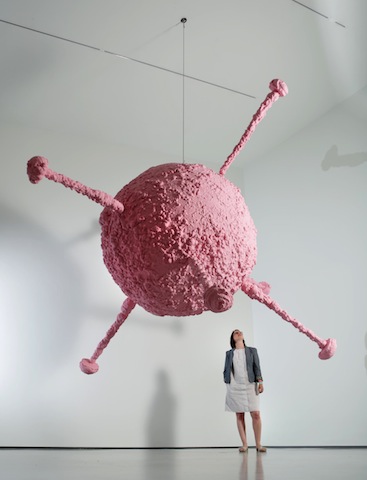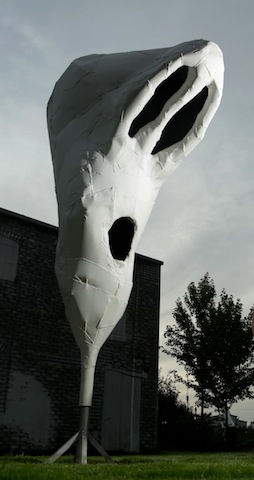The windows of Hepworth Wakefield command some attractive views, and for the present show looking out the window might even be a valid alternative to looking at the work. Curator Eva Badura-Triska reports that Austrian artist Franz West was a believer in the aura or the atmosphere of an art work. It hardly matters where you look. As if to prove the point there are installations which include chairs facing away from the work, or sofas angled to provide little point of focus. Sit still for as long as you want and soak up this extensive exhibition.
Where is My Eight is the gallery’s largest exhibition to date. It was developed in partnership with mumok in Vienna, with input from West, right up till his death in July, 2012. The strange title is a linguistic corruption of a work West made about losing weight rather than the number eight. And given the sort of work on display here in Wakefield, it figures that West would want us to bring our own associations to the phrase. This sets out to be a very democratic show.
If anything haunted West, it was the anarchic milieu of Vienna itself
It is not every day you’re encouraged to play with the art: two installations encourage you to interact to your heart’s content. Many of West’s works are both portable and playful and he arranges a deck of iron and plaster clubs for you to feel their heft and wield them in a creative way. And in case you’re feeling shy, there are a row of curtained bays in which to get to know these so-called “Adaptives” or Pass-stücke. Whether or not you do, you can still appreciate the way this piece collapses the triangle in which author, art work and audience are usually kept at a polite distance.
 West’s combination pieces stage sculpture, furniture and paintings in an ever-changing relationship to one another. It’s an early form of remix culture. These also include work by other artists – here you’ll find a glum-looking dog by Martin Kippenberger near a cartoon panel by Raymond Pettibon. The show is strong on these pieces, which evoke a domestic space rather than a white cube. Ironically, the chairs are by now too valuable to make use of. The injunction to look but not touch brings about a tension for the rest of your visit. (Pictured right: Epiphanias an Stühlen, 2011)
West’s combination pieces stage sculpture, furniture and paintings in an ever-changing relationship to one another. It’s an early form of remix culture. These also include work by other artists – here you’ll find a glum-looking dog by Martin Kippenberger near a cartoon panel by Raymond Pettibon. The show is strong on these pieces, which evoke a domestic space rather than a white cube. Ironically, the chairs are by now too valuable to make use of. The injunction to look but not touch brings about a tension for the rest of your visit. (Pictured right: Epiphanias an Stühlen, 2011)
West’s forays into what you might call interior design calls to mind the Haus Wittgenstein in Vienna. The philosopher spent a year designing fixtures and fittings for his modernist townhouse, and his work on language and meaning was an enduring inspiration for the local artist. Largely self-taught, West was an avid reader of philosophy and psychoanalysis, but having never gone to university it’s said he veered from intellectual snobbery to insecurity. As this show’s catalogue demonstrates, his output provides plenty of scope for theorising.
But don’t let the intellectual framework blind you to the vivid appeal of many of West’s sculptures. His candy-coloured palette clashes with his use of rough plaster and the contrast provides this show with many highlights. Chief among these is Parrhesia, 2012 (main picture), a group of seven misshapen forms which sit atop plinths and read like a group of heads in conversation. “Parrhesia” is a Greek concept which calls for us all to speak our minds at all times, regardless of the risk.
 Here is an artist alert to the biomorphic power of abstract forms. The curator has placed three large papier-mâché forms in a space with works by their namesake. Once you start seeing faces in Barbara Hepworth sculptures it’s hard to stop. But West’s pieces are as likely to haunt you as delight you. Outside, the gallery has installed the monumental head of a lemur (pictured left: Lemur Head, 2001). It is more zombie than marsupial.
Here is an artist alert to the biomorphic power of abstract forms. The curator has placed three large papier-mâché forms in a space with works by their namesake. Once you start seeing faces in Barbara Hepworth sculptures it’s hard to stop. But West’s pieces are as likely to haunt you as delight you. Outside, the gallery has installed the monumental head of a lemur (pictured left: Lemur Head, 2001). It is more zombie than marsupial.
If anything haunted West it was the anarchic milieu of Vienna itself. At the turn of the century Freud had unlocked the riotous unconscious. And in the 1960s the art scene was dominated by the notorious Actionists who frequently wound up doing jail time for their transgressive performances. While his ludic, permissive work might be seen as a reaction to the self-conscious heroics of the Actionists, it might be said that West’s work embodies a light form of rebellion and public disobedience.
The artist insisted he was not a “jester” but where interactive sculpture is concerned there will always be a certain amount of clowning. The uselessness of, say, the thick white tubes which comprise NYCNAC, 2008, is an occasion for mirth rather than po-faced critique and in this respect West reminds one of a leading exponent of Arte Povera, Pino Pascali, who filmed and photographed himself in playful dialogue with his sculpture. If sculpture came down off its plinth in the late 1950s, West, who was born in 1947, took the next step and put it into the hands of his audience.
As a result, repairs to his Adaptives were ongoing during his life and now that he is no longer with us the gallery has to limit any physical involvement with the work – we’re not allowed to sit on the sculpture. This is something you have to imagine. But this is one of the most tantalising shows you will see all year.









![SEX MONEY RACE RELIGION [2016] by Gilbert and George. Installation shot of Gilbert & George 21ST CENTURY PICTURES Hayward Gallery](/sites/default/files/styles/thumbnail_125_x_125_/public/mastimages/Gilbert%20%26%20George_%2021ST%20CENTURY%20PICTURES.%20SEX%20MONEY%20RACE%20RELIGION%20%5B2016%5D.%20Photo_%20Mark%20Blower.%20Courtesy%20of%20the%20Gilbert%20%26%20George%20and%20the%20Hayward%20Gallery._0.jpg?itok=3oW-Y84i)





Add comment